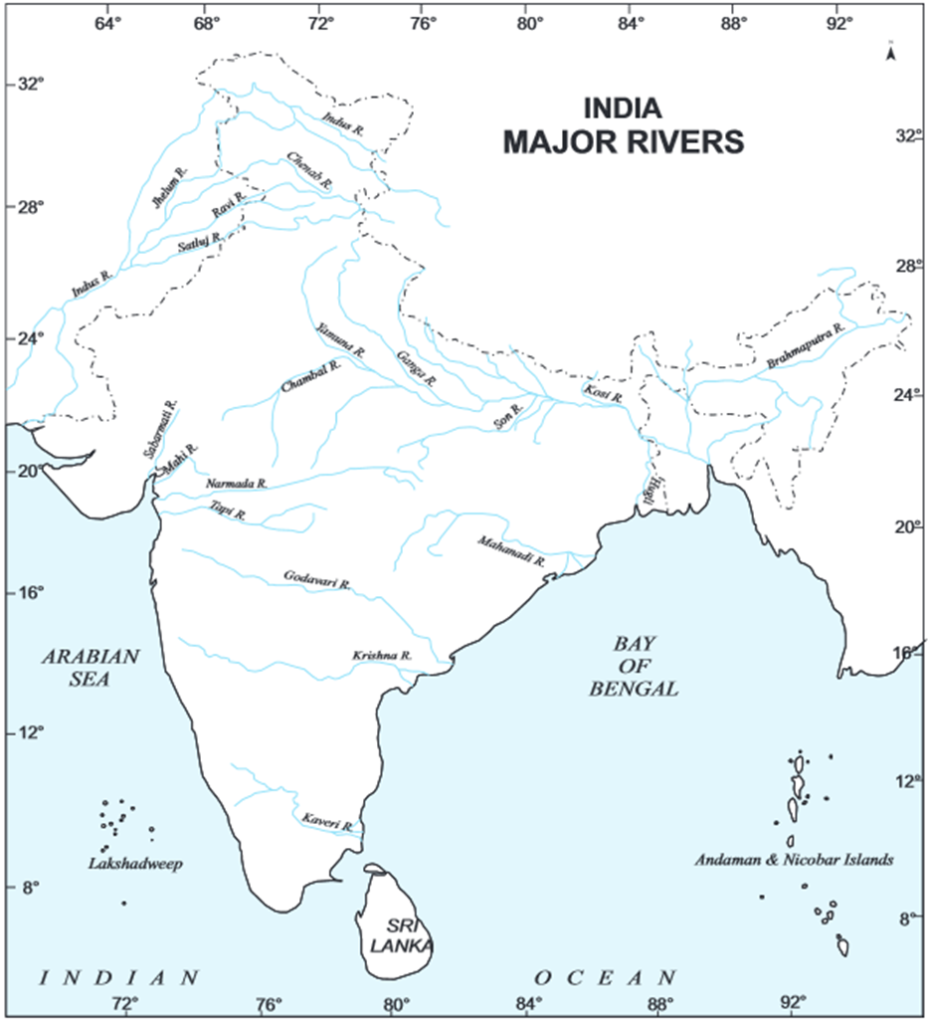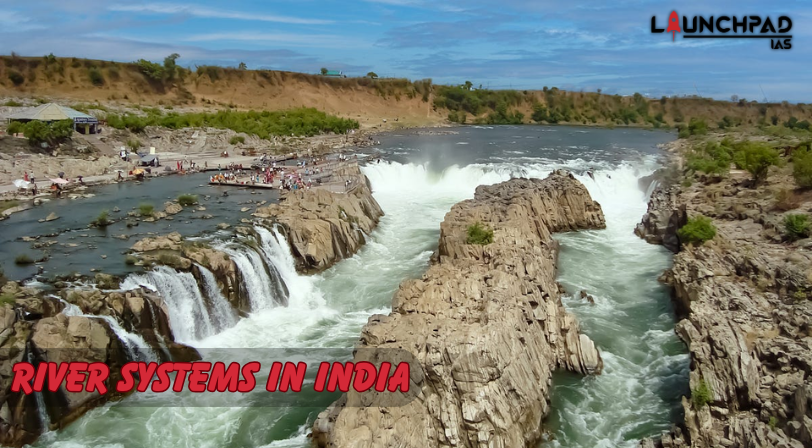River Systems in India can be broadly divided into 3 types :
- Himalayan River Systems – Indus, Brahmaputra, and Ganga River System
- Peninsular River Systems – Godavari, Krishna, Cauveri, and Mahanadi River System
- West Flowing Peninsular River Systems – Narmada, Tapti, Sabarmati River, Mahi, and Luni River
Indian River System and their Tributaries
Here is a brief detail of the Indian Rivers and their tributaries, i.e.,
- Indus River System
- Brahmaputra River System
- Ganga River System
- Narmada River System
- Yamuna River System
- Tapti River System
- Godavari River System
- Krishna River System
- Cauveri River System
- Mahanadi River System
1. Indus River System
Indus River, popularly known as the Puranik River, is one of the historical rivers found in mythological texts and great Hindu Sculptures. The key features of the Indus River System in India are as follows:
- It arises in Tibet from the northern slopes of the Kailash range of the Himalayas near Manasarovar Lake.
- Indus is one of the largest rivers, with significant tributaries from India and some parts of Pakistan.
- The River falls in the Arabian Sea near Karachi.
- The length of the river from its source to where it falls in the Arabian Sea is 2897 km.
- In India, it enters the JandK region and forms a picturesque gorge.
The major tributaries of the Indus River System are Sutlej, Beas, Chenab, Ravi, and Jhelum.
2. Brahmaputra River System
Like the Indus River System, the Brahmaputra River System originates from Manasarovar Lake. The key details of the Brahmaputra River System are as follows:
- Though the Brahmaputra is one of the major River systems in India, yet, most of its course lies outside of India.
- The total length of the Brahmaputra River System is 3848 km.
- It flows eastward, parallel to the Himalayas, and enters India in Arunachal Pradesh.
- Brahmaputra river is called as Dihang River in Arunachal Pradesh.
In Tibet, this Indian River System is known as the Tsangpo river. The Brahmaputra River System in India is considered the largest river in volume.
3. Ganga River System
The river Ganga derives its name from the Gangotri Glacier, its source. The Ganga River System is explained below:
- Bishenganga, Dhauliganga, Pindar, and Mandakini rivers merge into Ganga before it reaches Devprayag.
- At Karan Prayag, the Nanda Devi unites with the Alaknanda River while the Pindar River rises from the Eastern Trishul.
- At Rudraprayag, it is joined by the Mandakini.
- The river Alaknanda and Bhagirathi is known as Ganga at Devprayag.
The Ganga River System in India has the following tributaries – Son, Ghaghara, Gomati, Ram Ganga, Sapti Kosi, Damodar, and Yamuna.
4. Narmada River System
Located in central India, the Narmada River drains out into the Arabian sea from the Bharuch region of Gujarat. Its features are:
- It originates in Madhya Pradesh, from the Amarkantak Hills, and runs to Gujarat and Maharashtra.
- Narmada lines the traditional frontier between southern and Northern India.
- Narmada flows from east to west along with the Mahi and Tapti rivers.
- Like the Yamuna, the Narmada River drains out from the Bharuch district of Gujarat into the Arabian Sea.
5. Yamuna River System
The Yamuna River is the largest tributary of the Ganga River System. The key features of the Yamuna River System are as follows:
- Yamuna River originates in Uttarakhand from the Yamunotri glacier.
- The largest tributary of the Yamuna River System is Tons.
- The Yamuna catchment extends to Madhya Pradesh, Rajasthan, Haryana, Uttar Pradesh, Himachal Pradesh, and Delhi.
The prominent tributaries of the Yamuna River System in India are Chambal, Betwa Ken, Hindon, and Sin.
6. Tapti River System
The Tapti River System is one of the most important river systems in peninsular India that originates from Southern Madhya Pradesh in the east-to-west direction.
- It drains through South Gujarat, Khandesh of Maharashtra, East Vidarbha region, and Nimar region of Madhya Pradesh.
- Tapi’s river basin mostly lies in the northern and eastern districts of Maharastra and a few districts of Gujarat and Madhya Pradesh.
The prominent tributaries of the Tapi River System are the Bori River, Panzara River, Purna River, Girna River, Aner River, and Waghur River.
7. Godavari River System
The second largest Indian river system in terms of course with brownish water in India is the Godavari River System. The features are:
- It is called the Vriddh (old) Ganga or Dakshin (south) Ganga.
- The Godavari is one of the seasonal rivers in India that widens up during monsoons and gets dried during summers.
- The Godavari originates near Nasik from Trimbakeshwar in Maharashtra, flows through Orissa, Andhra Pradesh, Telangana, and Madhya Pradesh, and ends up in the Bay of Bengal.
- At Rajahmundry, it forms a delta.
- Its bank is considered holy and has been a pilgrimage site in Trimbak, Bhadrachalam, and Nasik.
Some of the major tributaries of the Godavari River System of India include Manjira, Sabari, Bindusara, Indravati River, and Pranahita. Also, Asia’s largest bridge (road-cum-rail) is located on the Godavari river. It links Rajahmundry and Kovvur.
8. Krishna River System
Krishna river originates from Mahabaleshwar, Maharashtra. It is one of the major rivers in India; in terms of length, that flows through Sangli and ends up at the Bay of Bengal.
- It flows through Andhra Pradesh, Telangana, Karnataka, and Maharashtra.
- One of its major tributaries, Tungabhadra, is formed by Bhadra and Tunga Rivers and originates from the Western Ghats.
The major tributaries of the Krishna River System are Musi, Yerla, Warna, Ghataprabha, Dindi, Mallaprabha, Bhima, Koyna, and Dudhganga.
9. Cauveri River System
The Cauveri River System originates from the Western Ghats and is one of the pilgrimage sites for Hindus in the Kodagu district, Karnataka.
- It flows through Karnataka and Tamil Nadu and drains at the Bay of Bengal.
- People have been dependent on Cauvery for irrigation and agriculture since ancient times.
The major tributaries of the Cauveri River Systems in India are Tirtha, Noyyal, Bhavani, Lokapavani, Kabini, Lakshmana, Amaravati, Hannuhole, Shimsha, Kapila, Hemavati, Shisha, and Arkavathy.
10. Mahanadi River System
The Mahanadi River System originates in central India from Satpura Range and flows in eastern India.
- It flows through Orissa, Jharkhand, Chhattisgarh, and Maharashtra.
- Hirakud Dam, the largest dam in India, is built on Mahanadi River System.
Concept of Perennial and Non-Perennial River Systems
- Perennial rivers are streams or rivers that constantly run across their riverbed for a whole year. The entire year, there is water in the riverbed of Perennial rivers.
- Non-perennial rivers are rivers or streams that do not flow continuously throughout the entire year. In contrast, the non-perennial rivers do not flow for at least a portion of the year.



